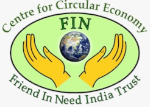
Jairaj Gopalakrishnan
FIN Intern – P2 Programme in Collaboration with Fusion Waste Management and Consultancy
Waste is a global issue. The world keeps generating more and more rubbish at an unsustainable rate. According to the World Bank, we produced close about two billion tons of waste in 2016, and the most common way we dispose of this waste is by dumping our waste in landfills[1]. While being the most common form of waste management globally, it is also one of the most problematic. For one, the decomposing waste in landfills generate massive amounts of methane and carbon dioxide, significantly contributing towards global warming and climate change. It is not just gasses though, landfills release liquids too, called leachates. This leachate usually permeates the soil and can contaminate underground and nearby water sources. While sanitary landfills are designed to keep the leachate away from water sources, there are many unsanitary landfills across the world. Furthermore, landfills require large amounts of space – millions of acres worldwide. So far, many have been of the opinion that when a landfill reaches their capacity, that land is wasted since the soil is nutrition deficient and the surrounding area is quite polluted. But many places in the US and countries around the world have started successfully repurposing landfills into parks, solar energy projects and wildlife habitats, amongst others. We discuss two such examples below.
a) Tel Aviv, Israel – Ariel Shannon Park
Between the years of 1952 and 1999, the mountainous landfill that once stood in Tel Aviv housed an unfathomable amount of waste. By its final year of operation in 1998, Hiriya was receiving 3000 tons of household waste a day. After nearly 16 million cubic meters of trash almost collapsed into the Ayalon riverbed and Tel Aviv’s pollution level continued to worsen, an outraged community forced its closure in 1998. In 1999, it became a transfer station, and rehabilitation plans began in 2001[2]. In an attempt to find solutions to the landfill problem, Israel hosted The International Competition for the Reclamation of the Hiriya Landfill, resulting in the selection of German landscape architect, Peter Latz (known for Landscape Park Duisborg-Nord in Germany), as a head urban planner for his innovative concept for transforming the garbage mound into usable, verdant land.
The planning of the grand park emphasized ecological considerations and highlights flood control, reserving surplus soil within the park, planting drought tolerant vegetation, reducing lawn areas and basing the planting scheme on dispersed groves and orchards on carobs, olive trees and sycamores. So, in addition to the mountain capping the landfill itself, surrounding agricultural fields and waterways were developed as wildlife habitat with man-made ponds, accessible via bike and walking trails[3]. The park acknowledges the contemporary planning concept for “Landscape Urbanism”, which generally perceives the landscape as a vehicle for urban renewal.
When assessing whether the rehabilitation of the landfill was worthwhile, we need to look at the benefits of engineering rehabilitation, i.e., reducing the environmental impact, as well as benefits from the architectural landscape rehabilitation, i.e., visual rehabilitation and benefits to the community with the construction of a grand park. The planning team estimated the cost of the engineering rehabilitation at approximately USD 42 million. Unfortunately, assessing architectural landscape rehabilitation is not as straightforward. A particular source estimates the total cost of rehabilitation ranging from USD 75 million to USD 97 million while the benefits range from USD 112.7 million to USD 248.7 million, indicating that the cost incurred is justified in lieu of the benefits[4].


b) Hong Kong – Sai Tso Wan Recreation Ground
From 1978 to 1981, the hill currently know as Sai Tso Wan Recreation Ground was known as Sai Tso Wan Landfill located in Lam Tin. During its operation, the landfill held approximately 1.6 million tons of domestic and commercial waste[5]. Trash in the landfill stacked up to 65 meters high. After its closure in 1981, it was sealed with soil and finally, post restoration and construction, opened up as a Multipurpose Recreation Ground on 2nd October 2004.
The Government of Hong Kong invited tenders for the Restoration and Aftercare of the closed landfills, one of which was Sai Tso Wan Landfill, on a Design, Build and Operate basis (DBO). During construction, the former landfill underwent a series of restoration works from 1995 to 2004. This included a final capping layer for prevention of leakage, a landfill gas control system for utilization of methane gas generated from the decomposed rubbish, and a leachate management system, a regular monitoring system of landfill gas, leachate, organic emission, noise, surface water, marine water, dust, odour etc. Additionally, the surface of landfills is landscaped with select species of plant.[6]
Today, the recreation ground comprises a multipurpose grass pitch for soccer and baseball, two batting cages for practicing baseball, a children’s play area, a jogging track, and ancillary facilities. To ensure that the area is safe for public use, pollution control facilities have been installed to prevent environmental pollution, as mentioned above. Some green features have also been incorporated in the design of the recreation ground. For example, rubber soil is used as sub-base material underneath the paving blocks. Rubber soil is a new lightweight and porous construction material produced from rubber chips derived from waste rubber tyres and cementitious materials. The paving blocks on the footpaths are made from construction waste and waste glass. Rubber mats used in the children’s play area and the jogging track are made from rubber chips derived from scrap tires. Other green features include a demonstration wind turbine and solar panels. Electricity generated from the wind turbine is used to power streetlights in the recreation ground while that from the solar panels is used for the fluorescent lights in the reception area and the exhaust fans of a storeroom. There is also an environmental gallery in the recreation ground to display information on waste management in Hong Kong.[7]
According to the Environmental Protection Department of Hong Kong, the restoration of Sai Tso Wan costed a capital amount of USD 249 million along with an annual operational cost of USD 9 million.[8]


[1] https://www.hazardouswasteexperts.com/landfills-an-unsustainable-form-of-waste-management/
[2] https://www.researchgate.net/publication/241730277_Ariel_Sharon_Park_and_the_Emergence_of_Israel%27s_Environmentalism
[3] https://dirt.asla.org/2015/03/10/the-mountain-of-crap-becomes-a-park/
[4] https://www.researchgate.net/publication/7395324_Economic_aspects_of_the_rehabilitation_of_the_Hiriya_landfill
[5] https://dumpsterrentalnoco.com/hong-kong-landfill-to-eco-park-sai-tso-wan-eco-park/
[6] https://www.iswa.org/uploads/tx_iswaknowledgebase/Paper_Barry_Adcock.pdf
[7] https://www.info.gov.hk/gia/general/200410/02/1002157.htm
[8] https://www.epd.gov.hk/epd/english/environmentinhk/waste/prob_solutions/msw_si_lra.html
Jairaj Gopalakrishnan
FIN Intern – P2 Programme in Collaboration with Fusion Waste Management and Consultancy

